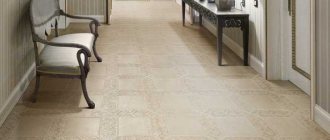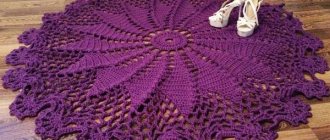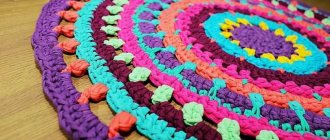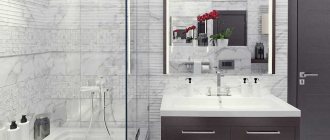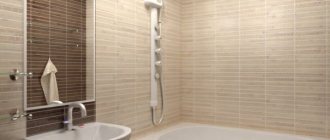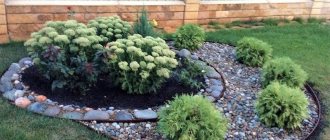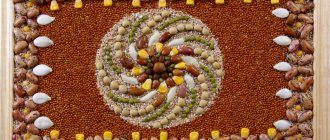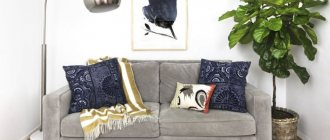Distinctive features of brown tiles
Initially, all floor tiles were ceramic and had a red-brown clay color. Now manufacturers offer products of any color, with a pattern and plain, glossy and matte. You can choose a covering to suit any interior, but brown floor tiles attract the most attention.
This color is convenient because it goes with any decor, fits into different interior styles, harmonizes with other colors and suits many rooms.
Floor Tile Design
Today, technologies for manufacturing porcelain stoneware flooring make it possible to apply any design to it. This helps to imitate wooden surfaces and achieve maximum resemblance to laminate panels.
In the hallway, wood-look and laminate-look flooring looks stylish and expensive, and also combines all the advantages of tiled and wooden floors. The color range is truly wide: for decorating the hallway you can find samples with imitation of aged wood or brushed oak in different tones from light brown to dark wenge.
A special place in the range of ceramic products is occupied by tiles imitating marble, granite, or onyx: its natural texture looks like natural stone. In the hallway this noble texture looks especially elegant.
The photo shows a matte wood-look finish, similar to a wax coating. Manufacturers also offer a glossy finish to imitate varnish.
Products in the patchwork style are becoming increasingly popular: these are patterned tiles that resemble a patchwork quilt. A multi-colored floor in the hallway will fit perfectly into the Provence or Scandi style and enliven the interior.
Hexagonal tiles reminiscent of a honeycomb are also successfully used in decorating the hallway.
Stone floor tiles
The main advantage of this coating is that it uses natural material.
The stone is carefully processed, giving it the desired shape, making it even and smooth. Such tiles are durable, strong, resistant to external influences, and environmentally friendly.
Natural stone has an original feature: the surface pattern is always unique.
However, this type of tile also has its disadvantages: it is heavy, cold and has a high price. The most common materials are granite and marble. Sandstone and slate are also used for flooring.
Note!
- Mosaic tiles: TOP-120 photos and videos of mosaic tile design ideas for kitchens and bathrooms. Pros and cons of mosaics, types and materials
Tile for backsplash: varieties of tile materials, colors and patterns. Methods for laying tiles on an apron (photo + video)
Tiles for the stove - TOP-150 photos and videos of design ideas for tiles for the stove. Requirements and features of tiles, criteria for choosing a suitable material
Among the more expensive options you can see serpentine and jadeite, while onyx is considered the most prestigious and valuable.
Ceramic tile
The most popular and widespread material is ceramics. It is ideal for decorating any room in the home. Most often used in the bathroom, kitchen, hallway.
Not only floor tiles, but also wall tiles are made from this material. It has the same qualities as stone, its only distinguishing feature is fragility.
Ceramic products have a more expanded range due to the variety of colors and patterns. Their surface may be smooth or rough and contain convex patterns.
Corridor tile color
The choice of floor tiles in the hallway is of great importance for the perception of the interior as a whole. Its color range is so diverse that the design is limited only by the taste preferences and imagination of the apartment owner.
White
White gloss looks elegant and goes with any shade. Shining tiles reflect light and expand the space. But for a corridor this is too slippery a coating, and on products with a rough surface and light grout the dirt will be more noticeable.
The photo shows white tiles at the entrance, combined with the walls and light wood.
Black
The corridor with the subfloor should be spacious enough, otherwise it will narrow the space even more. Damage is more noticeable on such a floor. Therefore, black tiles are often combined with white ones, laid in a checkerboard pattern.
Gray
The most popular and winning option for the hallway, it harmonizes with any wall design. Scratches and dirt are not so noticeable on it.
Beige
Beige is a neutral, warm tone. Such a floor in the hallway is more likely to serve as a backdrop to the decor than to attract attention.
Blue
A specific choice, therefore more often found in two-tone floor finishes.
In the photo, the contrasting blue edging favorably complements the ornament on a white background.
Red
This color in the hallway is often used in combination with white, or as part of ornaments in muted tones: pink, burgundy.
Combination of brown and other colors
Brown is one of the most common colors in interior design. It is convenient because it can harmonize with many colors. The website contains photos of brown tiles, which show several possible combinations.
The best option is to be next to various shades of your spectrum: beige, light brown, sand and coffee with milk. Walls and floors in colors of this warm range will be appropriate in any room.
The contrast of dark chocolate with white or milk looks very impressive. Light inserts on the walls create a feeling of expanding space. The surface of the products can be either matte or glossy.
An antique-style interior will shine with splendor if gold is added to brown. To ensure that tiles with gold splashes do not overwhelm you with luxury, you can liven up the interior with bright accessories and the addition of beige or light brown with a pinkish tint.
Golden brown will look perfect next to light shades of green. This combination is reminiscent of the colors of nature and evokes a feeling of peace.
Lightness and freshness will give the finish a blue or turquoise tint. Paired with dark chocolate it will look dignified and noble.
Brown tiles in the kitchen
Brown tiles imitating wood combine the external aesthetics of wood and the universal practicality of ceramics. It is easy to clean and there will be no ingrained coffee or juice stains, traces of furniture legs or dents or other mechanical damage on its surface. At the same time, a high-quality material may be indistinguishable from wood in appearance, and the difference will only be felt when touched. This effect is achieved due to the ability to give the tiles not only the desired color scheme, but also any necessary texture.
As for the properties and characteristics of this finishing material, they depend on the technology of its production. Depending on its purpose, it will have different properties. For example, for tiles used for exterior decoration of buildings, laying steps on external stairs, etc. frost resistance, wear resistance, and resistance to chemical and mechanical influences are very important.
On the one hand, the technology for producing ceramic tiles has the same basis as hundreds of years ago. The material for its production is clay, the naturalness of which ensures the high environmental friendliness of ceramic products. To impart hardness to the body of the ceramic tile, quartz sand and a number of other natural components are added to the mixture, providing the appropriate properties and characteristics. The resulting mixture is formed into a material and sent to a kiln for firing at high temperatures. For different types of ceramic tiles, the firing temperature can range from 1000 to 1300 degrees.
There are two molding methods: extrusion and pressing. In the first case, a mixture of clay, quartz sand and other components is brought to the state of a wet mass, which is molded through extruders, i.e. special holes. And in the second case, this mixture in dry form is brought to a homogeneous powder and formed by pressing and exposure to high pressure. Tiles made by pressing have a clearer shape geometry and a smoother surface.
In addition, the material can have a glazed or unglazed surface. For interior wall decoration, the first option is most often chosen, since the material has a more aesthetic and attractive appearance.
Brown tiles and interesting ideas
Floor or wall tiles in brown tones can transform a room, make it cozy and comfortable, bright and memorable.
To do this, you can use some design techniques: contrast of white furniture and chocolate floors, staggered arrangement of light and dark tiles, laying in diamond patterns, adding bright inserts and colorful panels.
